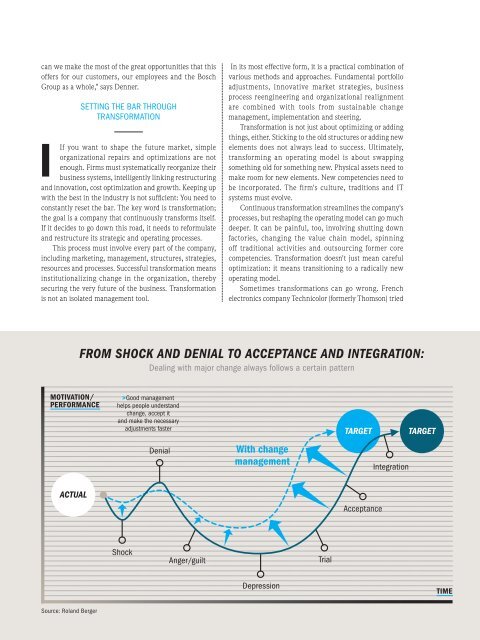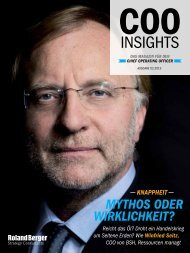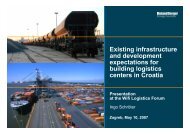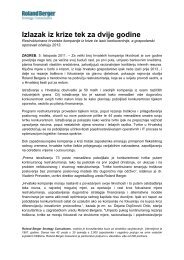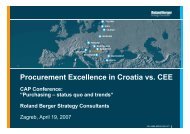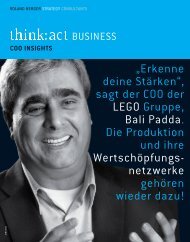COO Insights "Growth through transformation" - Roland Berger
COO Insights "Growth through transformation" - Roland Berger
COO Insights "Growth through transformation" - Roland Berger
Create successful ePaper yourself
Turn your PDF publications into a flip-book with our unique Google optimized e-Paper software.
can we make the most of the great opportunities that this<br />
offers for our customers, our employees and the Bosch<br />
Group as a whole," says Denner.<br />
SETTING THE BAR THROUGH<br />
TRANSFORMATION<br />
I<br />
If you want to shape the future market, simple<br />
organizational repairs and optimizations are not<br />
enough. Firms must systematically reorganize their<br />
business systems, intelligently linking restructuring<br />
and innovation, cost optimization and growth. Keeping up<br />
with the best in the industry is not suffi cient: You need to<br />
constantly reset the bar. The key word is transformation;<br />
the goal is a company that continuously transforms itself.<br />
If it decides to go down this road, it needs to reformulate<br />
and restructure its strategic and operating processes.<br />
This process must involve every part of the company,<br />
including marketing, management, structures, strategies,<br />
resources and processes. Successful transformation means<br />
institutionalizing change in the organization, thereby<br />
securing the very future of the business. Transformation<br />
is not an isolated management tool.<br />
In its most effective form, it is a practical combination of<br />
various methods and approaches. Fundamental portfolio<br />
adjustments, innovative market strategies, business<br />
process reengineering and organizational realignment<br />
are combined with tools from sustainable change<br />
management, implementation and steering.<br />
Transformation is not just about optimizing or adding<br />
things, either. Sticking to the old structures or adding new<br />
elements does not always lead to success. Ultimately,<br />
transforming an operating model is about swapping<br />
something old for something new. Physical assets need to<br />
make room for new elements. New competencies need to<br />
be incorporated. The firm's culture, traditions and IT<br />
systems must evolve.<br />
Continuous transformation streamlines the company's<br />
processes, but reshaping the operating model can go much<br />
deeper. It can be painful, too, involving shutting down<br />
factories, changing the value chain model, spinning<br />
off traditional activities and outsourcing former core<br />
competencies. Transformation doesn't just mean careful<br />
optimization: it means transitioning to a radically new<br />
operating model.<br />
Sometimes transformations can go wrong. French<br />
electronics company Technicolor (formerly Thomson) tried<br />
FROM SHOCK AND DENIAL TO ACCEPTANCE AND INTEGRATION:<br />
Dealing with major change always follows a certain pattern<br />
MOTIVATION/<br />
PERFORMANCE<br />
>Good management<br />
helps people understand<br />
change, accept it<br />
and make the necessary<br />
adjustments faster<br />
TARGET<br />
TARGET<br />
Denial<br />
With change<br />
management<br />
Integration<br />
ACTUAL<br />
Acceptance<br />
Shock<br />
Anger/guilt<br />
Trial<br />
Depression<br />
TIME<br />
Source: <strong>Roland</strong> <strong>Berger</strong>


